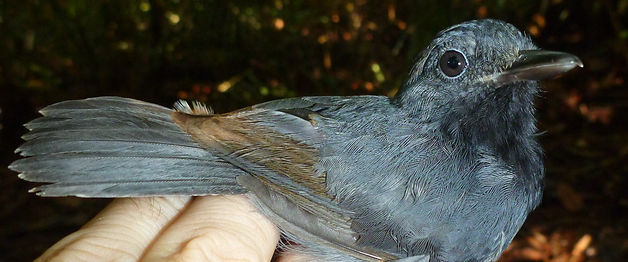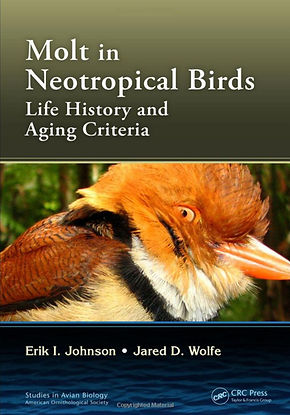
Wolfe Laboratory
Michigan Technological University
The following are modified instructions for aging captured birds using the WRP system taken from Molt in Neotropical Birds: Life History and Aging Criteria by Erik I. Johnson and Jared D. Wolfe. This is a small portion of the introduction and I suggest purchasing the book for a detailed description of using the WRP system. You can also watch a gentle introduction to WRP, or download a 2-page primer to the WRP system here.
WRP age-classification system
Wolfe et al. (2010) introduced a transformative cycle-based aging system (also known as the WRP system), which was further refined by Johnson et al. (2011) and Pyle et al. (2015), based on the sequence of molts and plumages through which birds progress during their life. With this system, aging codes are not based on calendar years (as in the standard North American aging system) or relative to breeding status (as followed in many European references), but are instead derived from Humphrey and Parkes (1959) molt and plumage terminology modified by Howell et al. (2003). This approach strives to standardize terminology based on perceived molt homologies across each species’ annual cycle.
The WRP aging system allows for the maximum accuracy of aging birds based on their molt and plumage state. Like any other avian aging system, it requires knowledge of three important points: 1) the molt strategy, 2) the extent of each molt, and 3) the plumage aspect resulting from each molt. Once these are known, then each bird captured, collected, or observed can be given a cycle code based on its molt and plumage state. Even if one or more of these points is not known, the cycle code system can account for this uncertainty.
The WRP system uses a three-letter code (see Table 1 & 2 below), with standardized options available for each letter. It is perhaps easiest to start with the first and last letter as these refer to the cycle and plumage, respectively, which one wishes to reference. The middle letter provides context of each captured bird relative to the presence of active molt. To apply the WRP system to an individual bird, imagine a scenario in which one captures a bird in juvenile plumage that is not molting. Because it is in its first cycle, it would be coded as F (first cycle), C (not molting, i.e., ‘cycle’), and J (juvenile plumage), or ‘FCJ’. Because Howell et al. (2003) redefined the juvenile plumage as the first basic, we could actually also call this bird a FCB. However, like Howell et al. (2003), we prefer to use the term ‘juvenile’ because of its familiarity and avoid any use of FCB in the cycle-code system. If this same bird were molting into this plumage, we would simply replace the ‘C’ for ‘P’, and age the bird as an FPJ. If we recapture this same bird later, but do not know which plumage it is in (for example, perhaps formative, or perhaps definitive basic, or perhaps first or definitive alternate), we would change the middle letter to ‘A’, meaning it is after ‘first juvenile’ and use FAJ. The letter ‘U’ (unknown) can also be used in the first (cycle) or plumage (third) position, and in the previous circumstance, we could also use ‘UCU’, but because we have more accurate information, i.e., that it is not in juvenile plumage, we prefer the more specific use of FAJ.
Note that UAJ is not an appropriate code. In the WRP system, the cycle and plumage in the first and third positions, respectively, must be inherently linked such that a bird’s age may be “after first cycle juvenile,” but not “after an unknown-cycle juvenile.” This distinction becomes more important in birds with incomplete prebasic molts in which a minimum age (i.e., cycle and plumage) is known, such as when there are multiple generations of flight feathers and none are juvenile. For example, the code “TAB” would refer to “after third basic plumage.” If we were to call this bird “unknown cycle basic plumage”, or “UAB”, we lose the ability to archive whether this bird was a minimum of two, three, four, or more years.
Each of the four molt strategies outlined by Howell et al. (2003) in combination with the extents of each molt (complete versus something less than complete) result in a subset of codes among the entire list of possibilities. Obviously, this creates many options for aging. It should already be clear that some combinations are not possible and nonsensical, such as SCJ (second cycle juvenile) or DPF (definitive preformative). To successfully age birds and use the WRP system in practice, understanding why only certain codes are available is important. In theory, sequences of codes are slightly different than what we might actually use in practice, which is no different than any other age code system. For example, we may know in theory that the sequence of a Simple Basic Strategy is FPJ -> FCJ -> SPB -> SCB -> TPB -> TCB -> 4PB -> etc., but in reality if the SPB results in an adult-like plumage aspect thereby limiting our options to FPJ -> FCJ -> SPB -> DCB -> DPB -> DCB -> DPB -> etc.
Combining the four different molt strategies with molt extents, creates a practical utility of the cycle code system that essentially results in eight likely scenarios for implementation in most birds, with four of them being most likely in passerines, near-passerines, and even many other non-passerines (see also Pyle et al. 2015).


"Molt in Neotropical Birds" details molt strategies of tropical families, and provides detailed age and sex accounts for nearly 200 species.

Table 1.

Already familiar with WRP? Learn advanced codes and applications in Jared's blog post.
Table 2.
